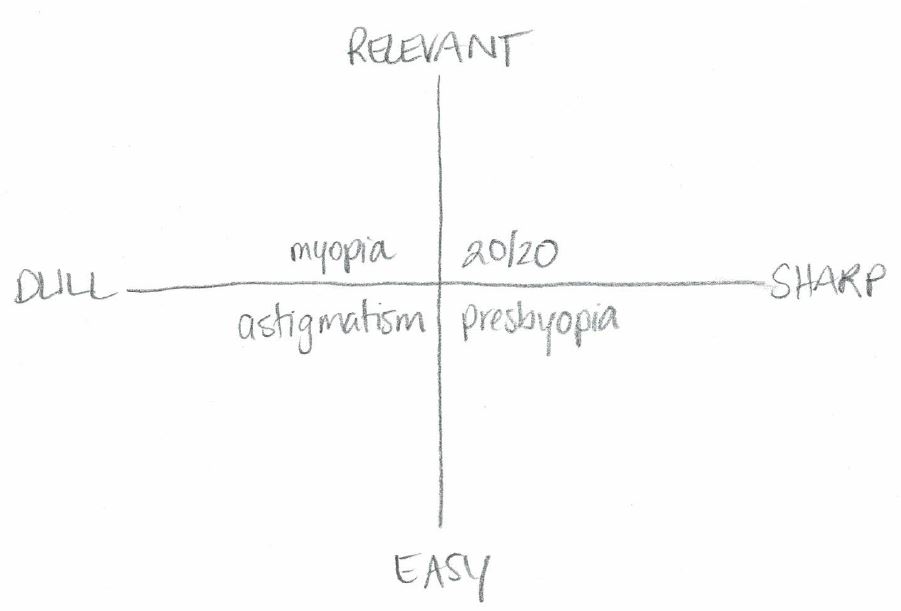Do You Have Enough KPI Acuity?
by Stacey BarrDoes your suite of KPIs or measures give you an accurate picture of performance, with enough clarity to see the biggest performance gaps?

Lots of strategic performance measures or KPIs (or metrics or indicators – they’re called so many different things) are a complete waste of time and space. Those KPIs are “but a walking shadow, a poor player that struts and frets his hour upon the stage and then is heard no more: it is a tale told by an idiot, full of sound and fury, signifying nothing.” (Macbeth)
Such KPIs lack acuity. If an organisation’s strategic KPIs lack enough acuity, they fail to guide or evaluate the success of strategy execution. Strategy execution isn’t about getting stuff done; it’s about achieving better results. It’s not about project management; it’s about performance improvement.
KPI acuity means accuracy and clarity.
We have KPI acuity when our measures of performance collectively give us an accurate enough picture of the performance that matters, in a way that’s clear to us.
A suite of KPIs has accuracy when they focus you on the performance that matters.
The accuracy of a suite of KPIs is different to the accuracy of each individual KPI’s data or calculation. Data and calculation accuracy both matter, but are useless if the KPI is measuring something that doesn’t matter right now.
We might evaluate the accuracy of a suite of KPIs along a spectrum. At one extreme we’d have ‘relevant’, based on how tightly the KPIs measure what is currently strategically important. And at the other extreme, rather than irrelevance, I’d suggest we have ‘easy’. This is because we find that the vast majority of KPIs that are not relevant are measured simply because they’re easy to quantify.
A suite of KPIs has clarity when they bring performance into sharp focus.
The clarity of a suite of KPIs is all about how quickly they collectively show us where performance needs to be improved right now.
A spectrum we might use to evaluate the clarity of a suite of KPIs could have at one extreme ‘sharp’ and at the other ‘dull’. How quickly can we cut through to the most important performance gaps to improve right now?
Use a model to evaluate your KPI acuity.
Our two spectrums of accuracy and clarity come together into a simple framework that can help us evaluate our current suite of KPIs:

Easy and dull KPIs are like having astigmatism: everything is blurry and distorted and we can’t focus on anything.
If you have astigmatism, it means much of what you try to focus on stays blurry and stretched out or distorted. You don’t know where you are, let alone where you should go.
Indexes or composite measures are an example of astigmatism-inducing measures. They’re usually constructed from many other measures that are easily available, but are a very poor proxy for the real measure we need but believe is impossible to get. Because they are composite measures, they are essentially very dull instruments because they average-out what’s really going on.
The biggest mistake that puts our KPIs into this quadrant is believing something is too intangible to measure directly. That’s a mistake, because with the right approach, almost anything that matters can be made measurable.
Easy and sharp KPIs are like having presbyopia: there’s too much irrelevant detail and we can’t focus on what matters.
If you have presbyopia, it means you’re having trouble focusing up close (like we all do as we age). You can’t figure out where you are now, even though you might be able to see where you want to go.
Measuring everything that we can in great detail, based on what data is already available and what we’ve traditionally measured (generally a lot of activity measures), is an example of presbyopia-inducing suite of KPIs. We struggle to get any focus at all on measures that matter in our pursuit of the results that matter.
The biggest mistake that puts our KPIs into this quadrant is laziness or ignorance in how we choose measures. Rather than brainstorming, being constrained by existing data, or making do with traditional measures, we should be designing them deliberately (and it’s not hard with the right measure design process).
Relevant but dull KPIs are like having myopia: we can’t see past the number in front of us.
If you have myopia, it means you’re nearsighted, and can really only focus on what’s right in front of you. You know where you are, but it’s hard to see where you’re going.
A measure of overall average customer satisfaction is an example of a myopia-inducing measure. Sure, it’s useful to measure this, but not when it’s measured annually and in isolation of sharper companion measures. It would be more useful if it was measured monthly or quarterly, alongside two or three measures that pinpointed specific customer service attributes that most needed improvement.
The biggest mistake that puts our KPIs into this quadrant is adopting the generic KPIs everyone else seems to be using for each class or category of strategic goal. Rather, we need to find KPIs that have pinpoint focus on our unique and current improvement priorities.
Relevant and sharp KPIs are like having 20/20 vision: we can focus on the detail of whatever matters most.
If you have 20/20 vision, it means you can easily focus clearly on whatever you need to. You know where you are now, and you can see where you need to go next.
The qualities of an excellent suite of KPIs that gives us 20/20 vision of organisational performance include:
- They are each aligned to a result that is currently strategically important.
- They are direct evidence of the result they are aligned to.
- They are quantitative.
- They can be monitored over time (not just at a point in time).
- They fall within the circle of influence of those who will use them.
How we get our KPIs into this quadrant is by taking a deliberate and prove performance measurement approach to designing them, so they align to strategy and are quantified appropriately. PuMP is a great example.
KPI acuity means your suite of KPIs accurately focuses you on the results that matter now, with enough clarity to decide what to improve now.
[tweet this]
TAKE ACTION:
Download this KPI Acuity template. Then open up your strategic plan and place your existing KPIs, measures, indicators or metrics (whatever you call them) into the quadrants. If you don’t have at least 80% of your KPIs in the top right quadrant, your strategic plan is mostly likely going to fail.
Connect with Stacey
Haven’t found what you’re looking for? Want more information? Fill out the form below and I’ll get in touch with you as soon as possible.
167 Eagle Street,
Brisbane Qld 4000,
Australia
ACN: 129953635
Director: Stacey Barr




